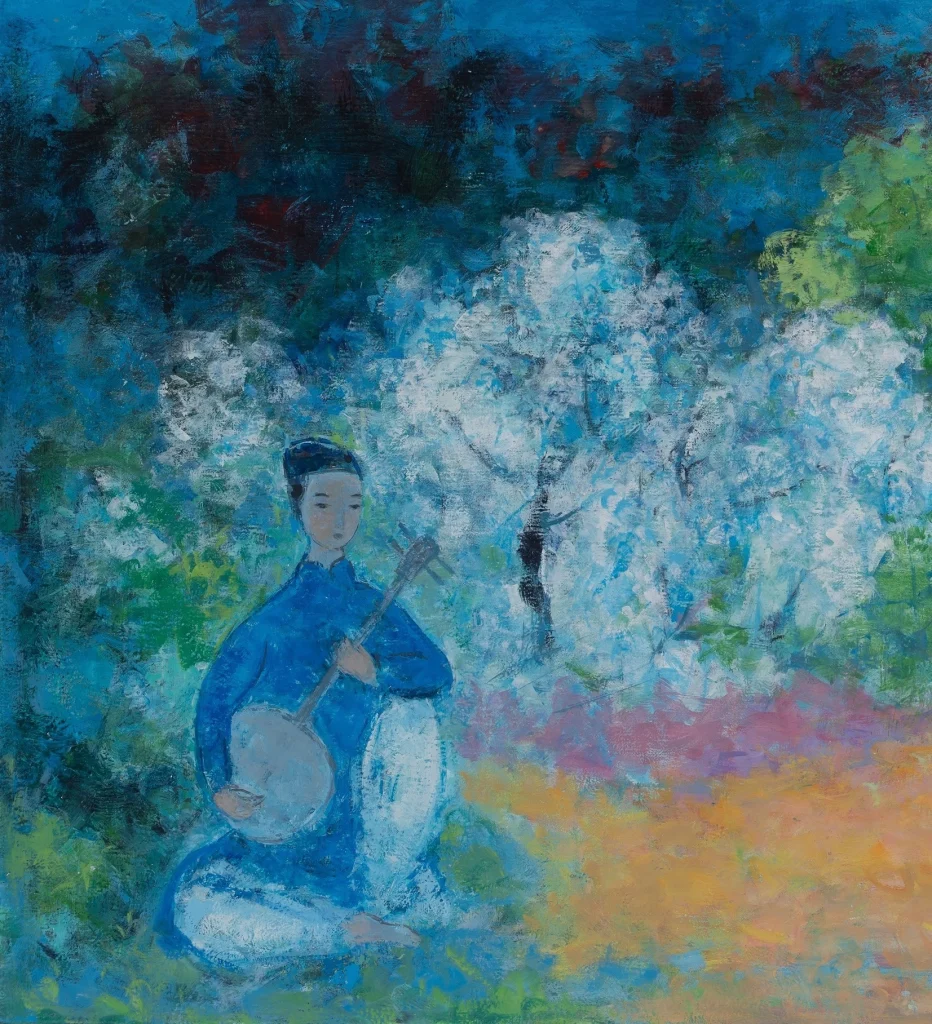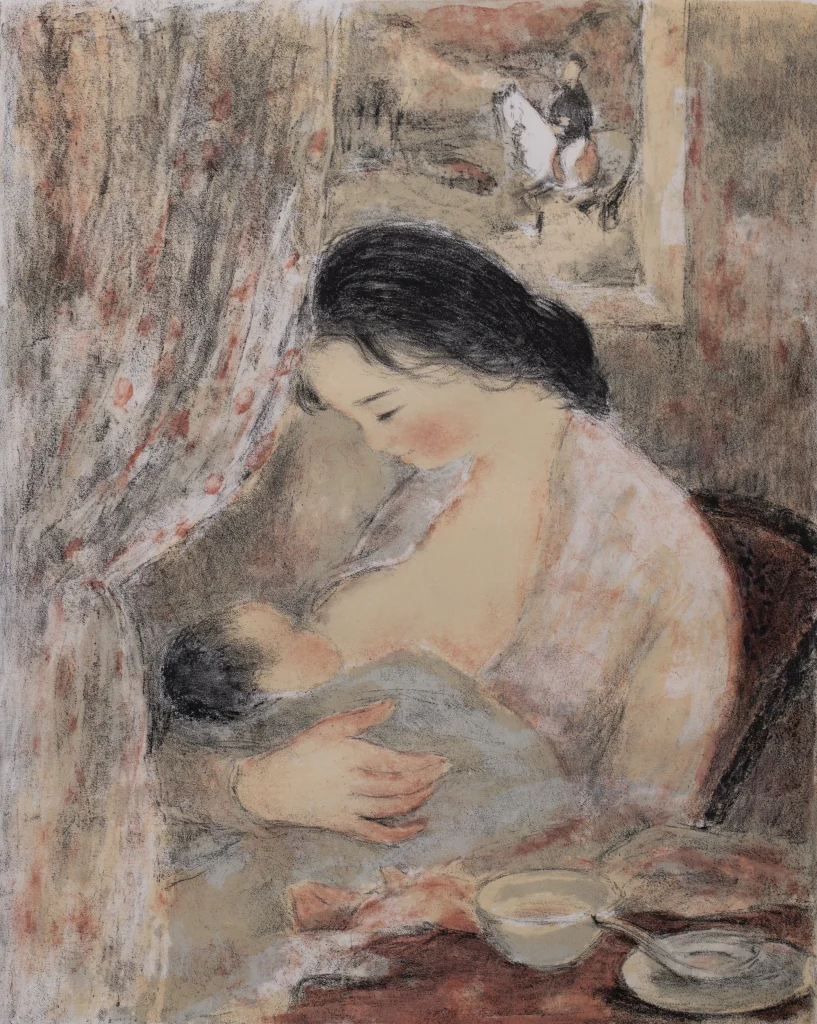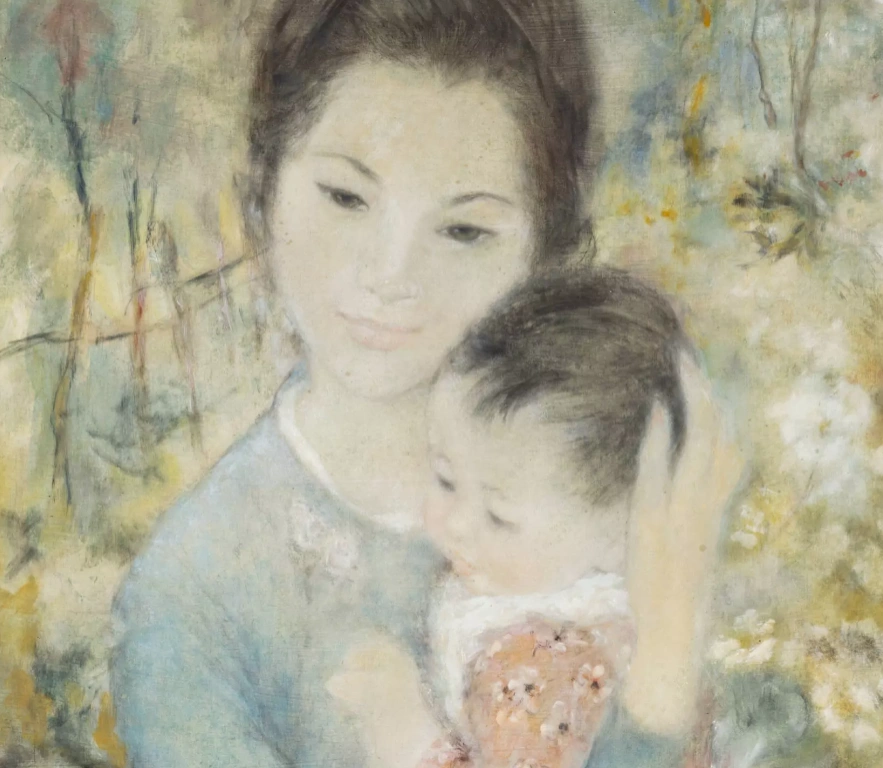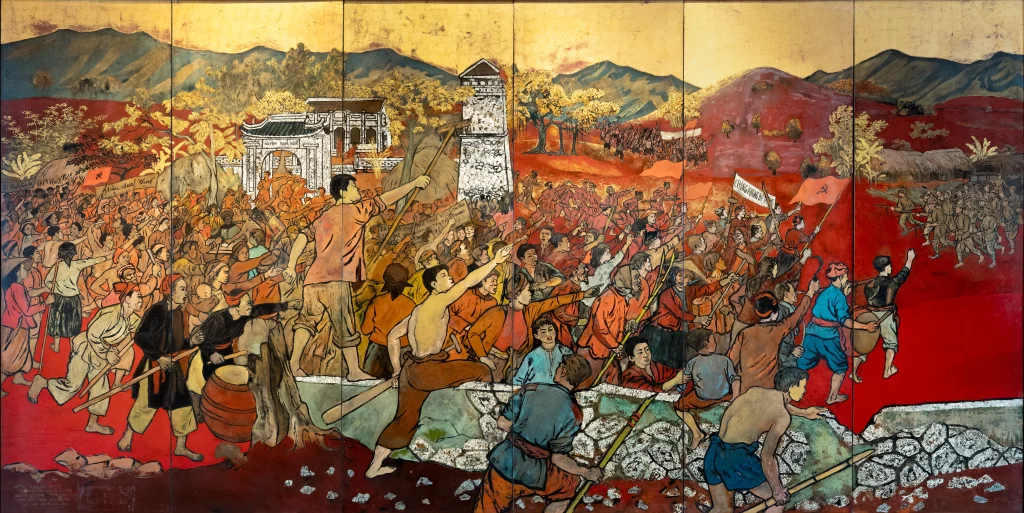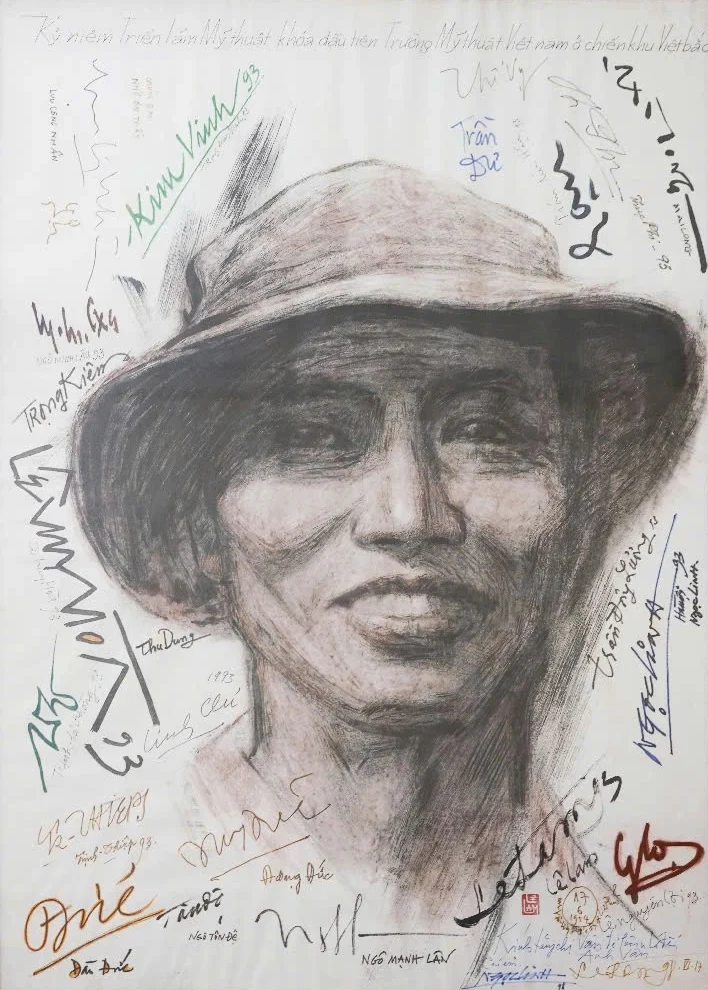“Thứ draws with a gentleness that we, some fiery men, do not have,” this is a sincere and affectionate saying of Vũ Cao Đàm about Mai Trung Thứ – a brother, a peer, a friend of him.
“Thứ draws with a gentleness” is perhaps the most accurate saying about Mai Trung Thứ’s style. And that gentleness is clearly shown in all of his works.
A number of perspectives in Mai Trung Thứ’s works
Mai Trung Thứ is not the first Vietnamese artist to reach a million-US dollar price for a work sold publicly on international auction blocks, but he is the first artist to have a work sold for 3.11 million USD, the “Portrait of Miss Phượng” (1930, oil, 135,5 × 80 cm).1 Currently (November 2025), no Vietnamese work has surpassed this (public) price.
In Việt Nam, Mai Trung Thứ painted on a number of medium, but since settling in France in 1937, he gave up oil, only work in silk. In a 1972 interview, he shared: “I also work in oil with Western style, but I know well that with the Western style I can’t stand out; while if I keep the Eastern technique, I can make my own mark.”2
It could be seen that Mai Trung Thứ’s creative thinking holds a strong personal mark. He decided to go till the end with silk by preserving the original Eastern medium and techniques, blending them with European academic art; taking inspiration from the people and traditional Vietnamese culture to create a unique painting language bearing his mark – elegant and distinctive. In addition, to give the works their own style, Mai Trung Thứ also made the frames for his silk works himself. Then, he directly drew on the frames the motifs inspired by traditional folk art.
During more than four decades living in France, Mai Trung Thứ had a rare steadfastness in his subject matter. His works did not aim at historical epics but focused on glorifying the beauty of everyday life, especially the beauty of women, children, mother and children, ethical traditions, religious rituals and cultural customs.
Mai Trung Thứ’s friend Lê Phổ once shared3 that he and Vũ Cao Đàm both liked European painting so they switched to oil, but Mai Thứ was different, Mai Thứ still worked in silk. This was the difference in Mai Thứ’s creative thinking, although the group of artists Phổ-Thứ-Lựu-Đàm all studied at Indochina Fine Arts College, and lived and worked in France. Although each artist in the group had outstanding achievements, Mai Trung Thứ’s success could be said to be the most special thanks to his personal determination in artistic creation.
Works of Mai Trung Thứ in the auction at Millon
In the auction titled “100 Years – Legends and the Future”, Millon introduces to collectors and art lovers a number of silk works created in different periods, from the 40s to the 70s (the last century). The highlight of this group of works is the feeling of Asian gentleness – his strongest and most profound language. Although these works were all created after Mai Trung Thứ went to France.
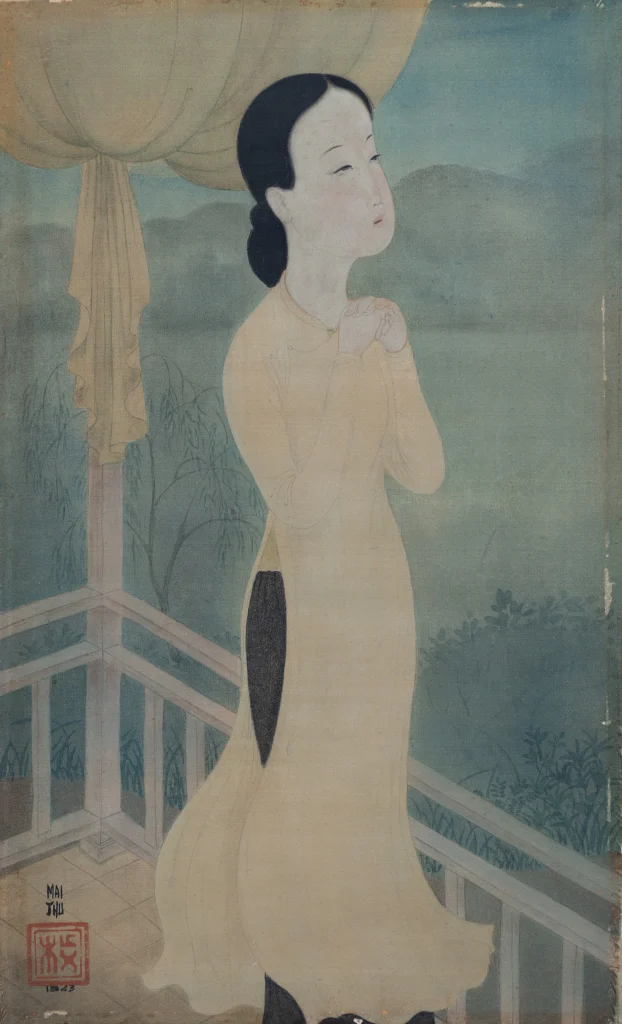
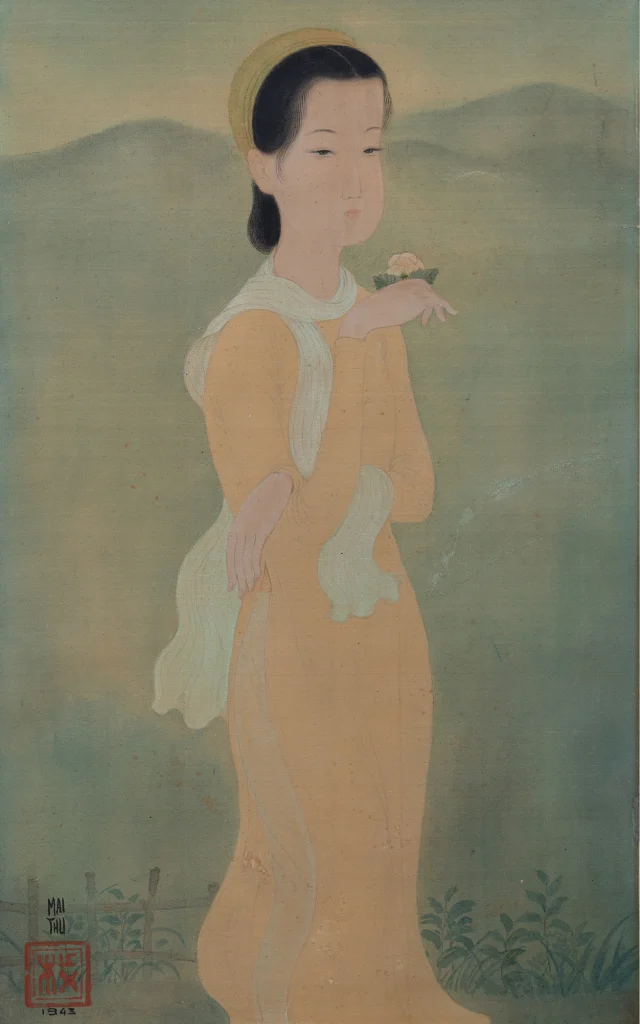
The two silk works of Mai Trung Thứ – Prayer and Girl with peony
The first two paintings, “Prayer” and “Girl with Peony” were both created in 1943. At that time, Europe was still immersed in World War II. Therefore, his works from this period are imbued with a gentle sadness of the time.
The work “Prayer” depicts a portrait of a very elegant young woman in a Vietnamese áo dài. She holds her hands tightly in front of her chest in a praying position. Viewers can feel her eyes are very gentle, looking up to the sky – full of hope for good things – it could be peace for the world – to come true.
The work “Girl with Peony” is also created according to a similar motif to “Prayer” with the same light, gentle color of orange, yellow and blue. The silk scarf draped loosely over her shoulders softens the feminine body, her eyes look down, far away and contemplatively, not looking at the peony in her hand. Perhaps in her mind at this time there is only the image of her parents, her lover…
Although the space in the two works is not clear with specific geographical features; but the images of mountains, rivers and lakes; plants such as peonies, willow trees; or architecture such as wooden wind-catching pavilions with soft silk curtains seem to depict the image of the Vietnamese homeland in a gentle nostalgia.
The character appearance of this period were still quite realistic with standard proportions according to academic anatomy. He only emphasized the height of the forehead with an oval face, and chubby cheeks, giving a feeling of innocence and softness.
In the 1940s, he created large-sized silk works, meticulously painted with layers, so it took a long time to complete, and silk was quite rare at that time. From the second half of the 1950s, he focused on small-sized works. There were works – each side was only from 10 cm to 20 cm. Mai Trung Thứ’s switch to small-sized works also had its reasons. Due to the characteristics of the material, large-sized silk works were rare, and it took a long time to paint, so the price was often expensive. Since the 1940s, Mai Trung Thứ’s works were popular in Europe. Therefore, he created small silk works to both solve the problem of materials and have reasonable prices for more art lovers. In addition, Mai Trung Thứ’s silk works were also printed by Braun printing house to increase their popularity. Therefore, Mai Trung Thứ’s works are the most widely known among Vietnamese artists living abroad. Especially the prints he published in collaboration with the United Nations Children’s Fund Unicef in the 1960s4.
However, in the late 1970s, he also created very large silk works (compared to himself) such as “Le concert”, 1978, silk, 92 × 65 cm5. This shows his consistency in materials and themes but also his great flexibility in aesthetic approach. The choice of large sizes for important works shows his strong creativity and his always purposeful concentration.
Looking at the entire system of Mai Trung Thứ’s works, it feels like he made his favorite themes over and over again. Why is that – because Mai Trung Thứ always absolutely adhered to his own choices. He repeated familiar themes but never mechanically. Just by changing a hand, a look, a costume, a flap of the áo dài, a space, a tapestry of vegetation… he created a new melody in his music of colors and shapes. Therefore, viewers never feel bored with the themes he had reaffirmed.

A work of Mai Trung Thứ – Kim Vân Kiều
Mai Trung Thứ was a person who played traditional Vietnamese musical instruments such as the monochord, the lute, the moon lute, and the zither. He once shared: “I draw like I play music – with my breath.” A relative said that he often listened to music while painting… music entered the brush strokes, blending painting and music, making Mai Trung Thứ’s paintings always rich in a very gentle “musicality”.
He created works with the theme of music with characters playing instruments and they were very popular with art lovers. In this work “Kim Vân Kiều”, we see a blend of poetry, music and painting. The work was created in 1951, at this time his drawing still followed the basic proportions. In the 1960s and 1970s, the proportion of the head to the body seemed to be emphasized.
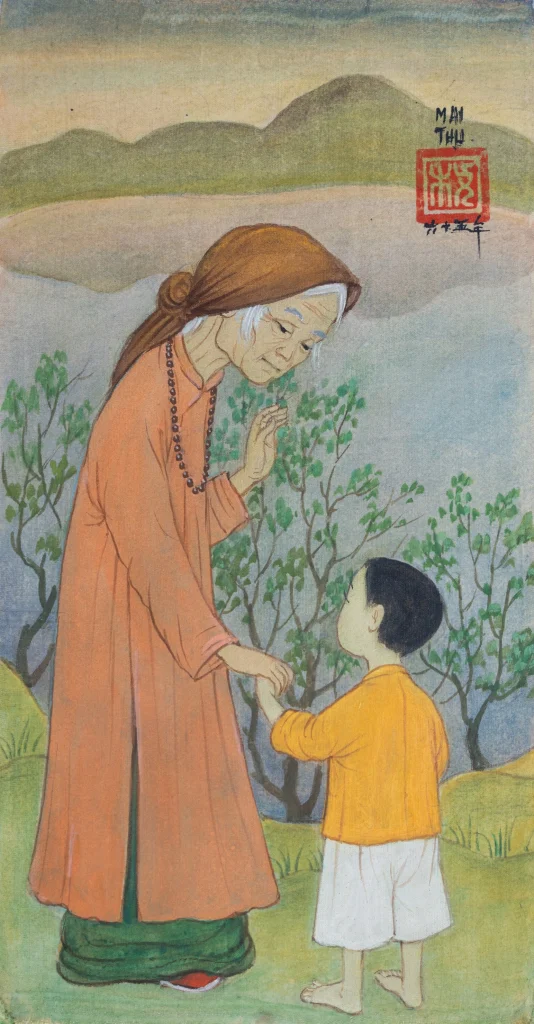


Mai Trung Thứ – “Grandmother”, “Missing” and “Girl with pink scarf”

Mai Trung Thứ – “Confidants by the lotus pond”
In some works of women, the arms seem to be longer and softer while the heads of children and old people tend to get bigger but basically still follow the rules of solid structural drawings of a person who is very good at visual art. The contours are thicker, more bold, and more free-spirited. The previous soft colors also seem more brilliant and contrasting. It is also possible that when he chose to make small-sized works, the colors needed to be more brilliant to attract the eye. But despite the obvious changes in colors and lines, the overall spirit in all of his works is gentle, soft, and bright. Looking at Mai Trung Thứ’s works, we could see that the heart seems to settle down to a feeling of happiness, relaxation, and peace.
Written by Viet Art View
Notes:
1, Auctioned at Sotheby’s April 18, 2021. Used to be in the collection of Ms Dothi Dumonteil – Đỗ Thị Tuyết, appeared in the movie “Mùi đu đủ xanh” 1993, Director Trần Anh Hùng.
2, According to the book “Mai Thu – Escho d’un Vietnam rêvé”, 2021.
3, Writer Thụy Khuê interviewd Lê Phổ.
4, The campaign “Helping Unfortunate Children” around 1960 – 1965 by Unicef.
5, Auctioned at Aguttes (France) September 2025, “Le concert” was sold for 55 billion VND.


